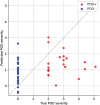Risk Factors for Postoperative Delirium Severity After Deep Brain Stimulation Surgery in Parkinson's Disease
- PMID: 39058451
- PMCID: PMC11380232
- DOI: 10.3233/JPD-230276
Risk Factors for Postoperative Delirium Severity After Deep Brain Stimulation Surgery in Parkinson's Disease
Abstract
Background: Postoperative delirium (POD) is a serious complication following deep brain stimulation (DBS) but only received little attention. Its main risk factors are higher age and preoperative cognitive deficits. These are also main risk factors for long-term cognitive decline after DBS in Parkinson's disease (PD).
Objective: To identify risk factors for POD severity after DBS surgery in PD.
Methods: 57 patients underwent DBS (21 female; age 60.2±8.2; disease duration 10.5±5.9 years). Preoperatively, general, PD- and surgery-specific predictors were recorded. Montreal Cognitive Assessment and the neuropsychological test battery CANTAB ConnectTM were used to test domain-specific cognition. Volumes of the cholinergic basal forebrain were calculated with voxel-based morphometry. POD severity was recorded with the delirium scales Confusion Assessment Method for Intensive Care Unit (CAM-ICU) and Nursing Delirium Scale (NU-DESC). Spearman correlations were calculated for univariate analysis of predictors and POD severity and linear regression with elastic net regularization and leave-one-out cross-validation was performed to fit a multivariable model.
Results: 21 patients (36.8%) showed mainly mild courses of POD following DBS. Correlation between predicted and true POD severity was significant (spearman rho = 0.365, p = 0.001). Influential predictors were age (p < 0.001), deficits in attention and motor speed (p = 0.002), visual learning (p = 0.036) as well as working memory (p < 0.001), Nucleus basalis of Meynert volumes (p = 0.003) and burst suppression (p = 0.005).
Conclusions: General but also PD- and surgery-specific factors were predictive of POD severity. These findings underline the multifaceted etiology of POD after DBS in PD. Valid predictive models must therefore consider general, PD- and surgery-specific factors.
Keywords: Parkinson’s disease; cognition; deep brain stimulation; outcome; personalized therapy; postoperative delirium; risk prediction.
Conflict of interest statement
GHS reports honoraria for lectures by Medtronic, Boston Scientific and Abbott. CS reports public grants from German Research Society, DLR, Einstein Foundation Berlin, G-BA, Inner University Grants, Project Management Agency, Non-Profit Society Promoting Science and Education, European Siciety of Anaesthesiology and Intensive Care, BMWI, Georg Thieme Verlag, Dr. F. Köhler Chemie GmbH, Sintetica GmbH, Max-Planck-Gesellschaft zur Förderung von Wissenschaften e.V., Metronic, Philips Electronics Nederland BV, RKI, BMBF and nonfinancial support from AWMF and Leopoldina. GE reports honoraria from AbbVie Pharma, BIAL Pharma, Desitin Pharma, STADA Pharma, ESTEVE Pharma, Neuraxpharm GmbH, Boehringer GmbH, speakers honorary from AbbVie Pharma, BIAL Pharma, Britannia Pharma, Desitin Pharma, ESTEVE Pharma, Licher GmbH, STADA Pharma, Zambon Pharma and Royalties from Kohlhammer Verlag, Thieme Verlag. AAK reports honoraria and non-financial support from Medtronic, honoraria from Boston Scientific, Ipsen Pharma and Abbott. DKW reports reports honoraria for lectures from BIAL Pharma and STADA Pharma. MA, MM, LMR, HS, SH, FB, JHH, BAF and CF have nothing to disclose.
Figures



References
-
- Armstrong MJ and Okun MS. Diagnosis and treatment of Parkinson disease: a review. JAMA 2020; 323: 548–560. - PubMed
-
- Aldecoa C, Bettelli G, Bilotta F, et al.. European Society of Anaesthesiology evidence-based and consensus-based guideline on postoperative delirium. Eur J Anaesthesiol 2017; 34: 192–214. - PubMed
-
- American Psychiatric Association. Diagnostic and Statistical Manual of Mental Disorders, https://cdn.website-editor.net/30f11123991548a0af708722d458e476/files/up... (2013, accessed 20.07.2022).
Publication types
MeSH terms
LinkOut - more resources
Full Text Sources
Medical
Research Materials

